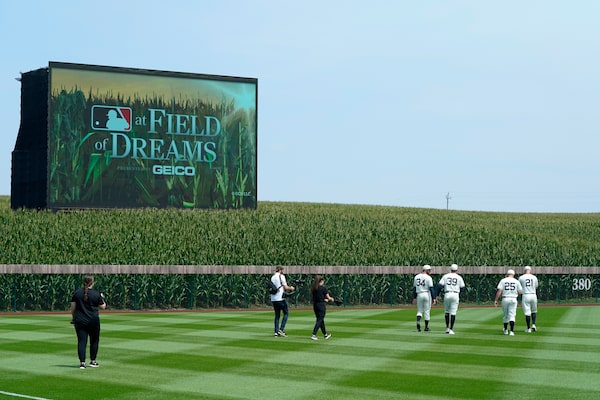
Chicago White Sox players walk on the field before a baseball game against the New York Yankees in Dyersville, Iowa, on Aug. 12, 2021.Charlie Neibergall/The Associated Press
Larry Cornies holds a standing appointment at the faculty of information and media studies at Western University.
It is fast becoming tradition that, during the dog days of summer, Major League Baseball shifts its fandom’s attention to a ball diamond amid cornfields in rural Iowa.
For marketing purposes, the timing is good: The season’s playoff picture is beginning to emerge, the midsummer all-star game is over, the trade deadline has passed, the World Series is still two months away. And in a normal growing season, the U.S. Midwest’s cornstalks have easily eclipsed the height of an average ballplayer.
Last year’s inaugural MLB at Field of Dreams game saw the Chicago White Sox come from behind in dramatic fashion to defeat the New York Yankees 9-8. This week’s contest pits the Chicago Cubs against the Cincinnati Reds.
The game, however, is another product of classic American mythmaking: equal parts fiction, fantasy, romance and nostalgia, with history looking on from somewhere in the distant bleachers.
Iowa has never had an MLB team. Its Field of Dreams, outside Dyersville, was conjured in the imagination of Canadian writer W.P. Kinsella, who published a novel titled Shoeless Joe in 1982. The ball diamond was built as a set for the feature film starring Kevin Costner. Even the MLB at Field of Dreams diamond is inauthentic: It was purpose-built for the television spectacle, 400 yards from the diamond used in the movie. Same cornfield; different site.
Canadians are prone to such industrial mythmaking, too. As proof, look no farther than a green-gabled house adjacent to a farmyard and haunted wood, near Cavendish, PEI. While the site intends to celebrate the literary legacy of L.M. Montgomery, most tourists flock there to see the early-20th-century home and environs of red-haired Anne Shirley, a purely fictional character.
Like other pro sports, baseball is rooted in folklore, fable, innovation and achievement. De-tangling those strands is as difficult and painstaking as picking creeping charlie from Kentucky bluegrass. The task has been left to baseball historians and fans.
Progress has been slow but steady. In his book Baseball’s Creation Myth, Canadian baseball historian Brian Martin notes that truth is finally beginning to triumph over fiction. Even MLB’s Hall of Fame in Cooperstown, N.Y., which long advanced the notion that the modern game was invented there by Abner Doubleday in 1839, no longer actively promotes that myth.
“More than enough evidence has emerged since the shrine to baseball opened [and even before that] to prove beyond a reasonable doubt the game did not begin there,” Mr. Martin wrote.
What was once a bat-and-ball game called rounders, played by English children and dating as far back the Elizabethan era, morphed and mutated many times as settlers brought the pastime to North America.
In the telling of baseball’s story, words and phrases matter. A former pasture in Beachville, Ont., is widely considered the site of the first recorded baseball game on June 4, 1838; however, the Gotham Club of New York is credited with drawing up the first rules for the modern game a year earlier.
Amateurs from several New York-area clubs gathered for games on the Elysian Fields outside Hoboken, N.J., in the fall of 1843. Fuller Field in Clinton, Mass., claims to be the home of the world’s oldest baseball diamond in continuous use, its home plate and bases being in the same locations as they were in 1878. Which explains why, at Labatt Park in London, Ont., visitors are told they’ve arrived at the world’s oldest baseball grounds in continuous use. Baseball has been played there since 1877. Flooding from the Thames River temporarily interrupted play at least twice; most notable was the great flood of 1937, which forced relocation of home plate to where right field had been. The gap in play for reconstruction lasted only a few weeks in spring, then games continued.
There’s nothing wrong with a little fun in an Iowa cornfield. But MLB could borrow a page from the National Hockey League – in fact, they could improve on it – by scheduling a baseball “heritage classic” game at venues that would at once honour the game and trace its origins for popular reference.
Imagine the possibilities: the New York Mets and the New York Yankees at Hoboken, near the site of the Elysian Fields; the Baltimore Orioles and the Pittsburgh Pirates at Doubleday Field in Cooperstown; the Boston Red Sox and the Philadelphia Phillies at Fuller Field in Clinton, Mass.; the Detroit Tigers and Toronto Blue Jays at Labatt Park in London, Ont.
People would come. People would most definitely come. And Major League Baseball would grasp an opportunity to demythologize and popularize its wonderful, if complicated, history.
Keep your Opinions sharp and informed. Get the Opinion newsletter. Sign up today.